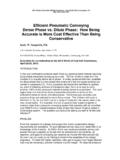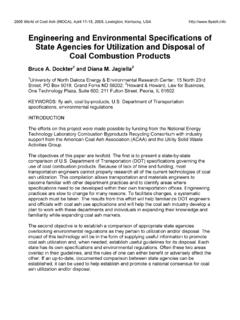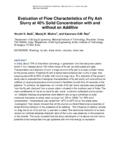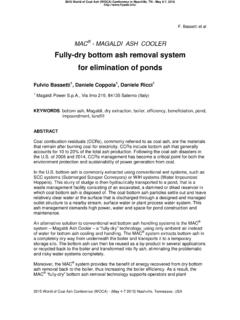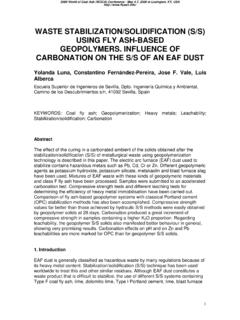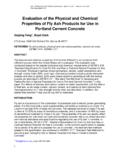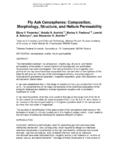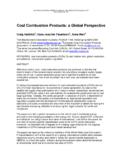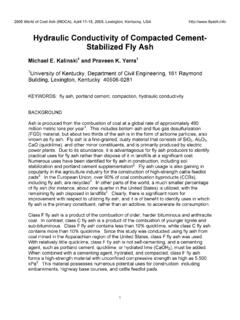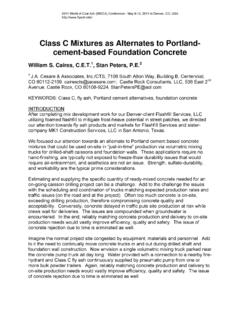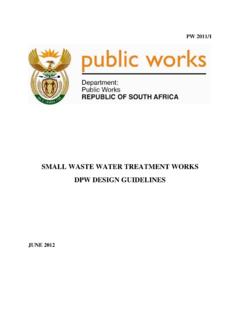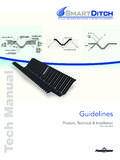Transcription of Operations and Maintenance Guidelines for Coal …
1 1 Operations and Maintenance Guidelines for Coal Ash Landfills Coal Ash Landfills are NOT the Same as Subtitle D Solid Waste Landfills Christopher D. Hardin, PE and Nick L. Perrotta, PE Haley and Aldrich, Inc. 1. INTRODUCTION: The number of coal ash landfills that have been constructed in the past five years has increased substantially since the promulgation of new State regulations for the handling and long-term storage of coal combustion residuals (CCRs). Many of these recently constructed coal ash landfills were designed using methods and materials that are common for Subtitle D, lined, municipal solid waste (MSW) landfills. Review of several landfill designs indicate that many CCR landfills have geotextile filter layers, leachate collection pipes, liner systems, stormwater management features and operational plans that are often just reformatted of a MSW landfill design.
2 Owners and operators of coal ash landfills have experienced problems with the design and operational plans for their landfills that are attributable to a minor, but important differences between MSW, Subtitle D lined landfills and CCR landfills. This paper will discuss and evaluate these differences and provide practical solutions for providing a better design and operational control for coal ash landfills. The overall purpose of this paper is to initiate discussion and technical interaction on what constitutes an effective CCR landfill design. It is recognized that CCR landfill design is a new and developing sub-field in the area of landfill design that merits additional discussion to develop best practices and design methods. 2. DIFFERENCES BETWEEN SOLID WASTE AND COAL ASH LANDFILLS To understand coal ash landfills that have experienced design and operational problems, it is helpful to consider the primary differences between the waste materials at MSW landfills and those at coal ash or CCR landfills.
3 A few of the key differences are: Difference -- Particle Size: Coal ash is a homogeneous, mostly fine particle material that requires special sizing of the geotextile or aggregate drainage/filter layer to prevent clogging. MSW is a heterogeneous, large dimension, inconsistent size particles. Difference No. 2 Odors and Vector Control: Coal ash has very little organic fraction and therefore has almost no noticeable odor and off gases and minimal/no settlement issues. Coal ash typically does not need daily cover to prevent disease and rodent issues. MSW tends to have significant odor and vector issues if not placed, compacted and covered with daily cover soils or fabrics. After placement, the organic material in MSW will continue to degrade producing methane and odors that must be managed and settlement issues. Difference No. 3 Erodability and Moisture Sensitivity As a predominately silt-sized particle, coal ash is susceptible to erosion.
4 Coal ash can lose strength quickly when in the presence of water if it is not compacted at or near the optimum moisture content. Most MSW comes to the landfill several percentage points below its saturation moisture content, and can absorb large amounts of moisture without an immediate loss in shear strength. MSW is not susceptible to erosion but is susceptible to blowing. Difference No. 4 Dust Control Coal ash can have significant issues with rapid surface drying, creation of dust and blowing of dust to off-site locations. These conditions can be difficult to control. At times, MSW is also difficult to contain with fences required to catch blowing trash. Most mixed MSW does not dry out as quickly as coal ash. 2011 World of Coal Ash (WOCA) Conference May 9-12, 2011 in Denver, CO, USA 3. COMMON PROBLEMS AND SOLUTIONS This section will highlight a few of the common problems that have been encountered by operators of coal ash landfills.
5 Problem No. 1: Ponded Surface Water above Leachate Collection Layers It is common after the initial layers of ash have been placed for the surface water and runoff to build up in the landfill. This greatly reduces the collection system efficiency and the available storage volume in the landfill. It is often assumed that this is caused by plugged geocomposite and geonets. Recent testing indicates that the geocomposites and geonets still maintain a higher permeability than lose or compacted coal ash. This suggests that the problem is not with the geotextile or leachate collection layer, but the reduced infiltration rate of leachate through the compacted layers of coal ash. To allow drainage of run-off from the surface of the coal ash to reach the .leachate collection layer, some type of vertical/horizontal connection to the leachate collection system using a chimney drain or a drainage layer is often required.
6 Chimney drains are typically constructed in sections as the CCR is placed, and connected directly to the horizontal leachate collect system. See Figure 1. A few important considerations for the design and installation of chimney drains: Locate the drains at a frequent enough spacing to handle runoff from large interior drainage areas that could occur during a wide variety of interim fill conditions. Size the chimney drain pipe and inlet for Peak Flow with a percentage of the surface water diverted to chimney drains and leachate collection system, based on a 10-year to 25-year storm. Divert most of the surface water away from the chimney drains and to surface water collectors without contacting the CCR material. This may require the installation of soil berms to control runoff/run-on, and rain covers to prevent infiltration of surface water. Provide adequate surface water diversion to direct large storm events to stormwater management ponds instead of overtopping the CCR landfill embankments.
7 This may require redundant stormwater channels and/or interim soil diversion berms as part of the CCR landfill plans. Include daily inspection, cleanout and Maintenance of chimney drain inlets in the operation and Maintenance plan for the CCR landfill. Drainage layers are typically constructed as the CCR is placed, and connected directly to the leachate collect system. See Figure 2. A few important considerations for the design and installation of drainage layers: Generally, CCR is placed in 15-30 foot thick lifts sandwiched between 1-2 foot thick drainage layers of granular drainage material. The drainage layer is placed at a minimum 5-percent slope, toward exterior and interior berms, to promote drainage and dewatering of the CCR layers. The CCR is placed and compacted in a controlled manner such that stormwater sheets off toward the leachate collection system. The granular drainage material may be segregated bottom ash or other waste byproduct that exhibits a homogeneous particle size suitable.
8 Perform annual NDG testing to document CCR is placed and compacted in accordance with the approved design. Perform as-built surveys to document each drainage layer has been constructed in accordance with the approved design. 3 Problem No. 2: Undersized Stormwater Management and Sediment Control Structures As mentioned in the previous section, coal ash is a silt-sized particle that is highly susceptible to erosion and changes in moisture content. This material characteristic frequently results in stormwater management ponds (SWMP) and erosion control (E&S) devices that are filled with coal ash to capacity at more frequent intervals. These tendencies must be accounted for in the design by providing additional storage capacity and/or more frequent pond cleanouts and Maintenance . A few important items to consider in the design of SWM ponds and E&S devices on CCR landfills include: More frequent rock check dams in the surface water channels draining to the SWM ponds.
9 Require more Maintenance and cleanout of devices to account for silt-sized, more erodible coal ash. Consider the design of a two-stage SWM pond with smaller fore-bay structure that can be cleaned at more frequent intervals. Consider the use of turbidity curtains and other methods to promote settling and removal of silt-sized particles Oversize SWM ponds and E&S devices to account for the increased volume of silt-sized coal ash particles. Monitor the levels in ponds to verify when it is time to clean. Problem No. 3: Dust Control and Blowing Ash As a silt-sized material, coal ash is notorious for rapid surface drying that produces dust within a few hours after the initial placement and compaction. Common solutions include continuous spraying with water and covering with cover soils. Other solutions include: Minimizing the size of the working face or CCR placement area so that wetter, partially saturated ash is placed over drying layers.
10 Placement of surface encapsulation product like Posi-shell and Gorilla Snot at the end daily Operations . Covering with temporary geotextile or raincovers that can be reused and moved to new placement areas as the fill placement progresses. 4. DESIGN SOLUTIONS FOR COAL ASH LANDFILLS This section provides a summary of a few design methods that have been used on coal ash landfills to increase the efficiency of CCR placement and compaction. By providing this summary the authors of the paper also recognize that there are many new and innovative ideas that are currently being used on other sites that are not mentioned. Leachate Collection and Geotextile Design To avoid the potential of a clogged and/or blocked leachate collection system during a major storm event, the components of the leachate collection system must be designed to handle silt-sized particles. The design may include a combination of redundant measures like over-sized silt traps and/or more frequent Maintenance of the inlet structures and geotextile surface.
